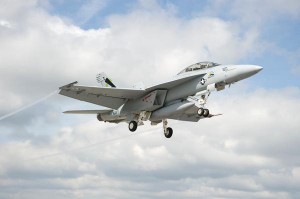Navy Bets on Biofuels
This past year has been an exciting time for the Naval Air Systems Command’s fuels team at Naval Air Station Patuxent River, as they have powered aircraft after aircraft on a new form of jet fuel partially derived from plant seeds.
It has also been a bit of heartburn for Navy leadership as they have been defending the procurement of this expensive, experimental fuel in front of a Congress desperate to find budget savings in a down economy.
While hardly the military’s largest testing program, biofuels development has become the symbolic target of lawmakers who see the program as an idealistic and costly departure from the Navy’s core mission of defending the country. The Navy, however, defends the program, saying that it is necessary to develop fuels that can provide energy security in the event that the nation’s supply of fossil petroleum fuels is disrupted.

An F/A-18 Super Hornet from Squadron VX-23 with green markings and the U.S. Department of the Navy Energy Security logo. (Navy photo)
The ongoing contrast between the Navy’s technical advancements in biofuels and the budget wrangling in Congress first emerged in April 2010, when Navy Secretary Ray Mabus made a well-publicized visit to Pax River on Earth Day to tout a public demonstration of the “Green Hornet,” one of the Boeing F/A-18 aircraft used to test a blended fuel similar to JP-5. Sec. Mabus declared the airplane to be a prototype for the Navy’s future “Great Green Fleet,” powered by renewable energy.
Over the next two years, NAVAIR’s fuels team certified several Navy jets and rotor aircraft to use the new fuel, publicly announcing each new flight. Sec. Mabus visited Pax River again last September to tout the fact that the Blue Angels would be flying their air show routine using the jet fuel blend. In April, Mabus lauded the fuels team with his annual environmental award. The fuels team’s tests went high-profile again in July with the RIMPAC exercise, which tested multiple Navy ships and aircraft on the new fuels in an operational environment.
Meanwhile, the program came under fire from Rep. Randy Forbes, a Republican from Virgina, who questioned in April whether the program’s cost would cut into the Navy’s shipbuilding budget. Throughout May and June, Navy leaders pleaded with House lawmakers to leave funding for the program in the fiscal 2013 defense budget.
In July, the Obama administration committed to spending $62 million to support biofuels production and called Congressional opponents short-sighted. At the same time, ads attacking specific House members for their opposition to biofuels hit the airwaves. Mabus took to his Facebook page to defend the program, which prompted a terse response from GOP Sen. John McCain.
In August, the Senate included some funding for biofuels in its defense funding bill, but Republican language banning biofuel purchases remained in the defense bill. However, Congress’ funding bills have been put on hold in favor of a continuing resolution maintaining FY 2012 funding levels through March 2013.

























